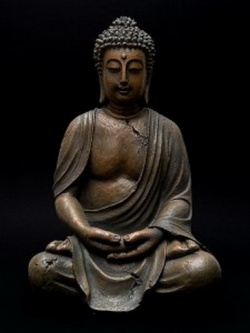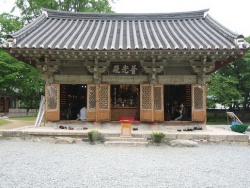Dharmapāla (Indian monk, translator)
Dharmapāla (traditional Chinese: 護法, pinyin: Hùfǎ) (530-561 CE). A Brahmin Buddhist scholar, he was one of the main teachers of the Yogacara school in India. He was a contemporary of Bhavaviveka (清辯, c. 490-570 CE.), with whom he debated.
Xuanzang, the famous Chinese pilgrim, tells that Dharmapāla was born in Kanchipuram, Tamil Nadu. He was a son of a high official, and betrothed to a daughter of the king, but escaped on the eve of the wedding feast, entered the order, studied all views, from Hinayana as well as Mahayana, and attained to reverence and distinction. He studied in Nalanda as a student of Dignāga. Later he succeeded him as abbot of the University. He spent his last years near the Bodhi tree, where he died.
Dharmapāla developed the theory that the external things do not exist and consciousness only exists. He explains the manifestation of the phenomenal world as arising from the eight consciousness.
Through the teachings of his disciple Silabhadra to Xuanzang, Dharmapāla’s tenets expanded greatly in China. His works survive in Chinese translations.
An Indian scholar of the Consciousness-Only school. One of the ten great scholars of the school, he contributed greatly to establishing its theoretical basis. Born in southern India, he became a monk on the eve of his planned marriage. He studied both Hinayana and Mahayana, and while still young, he became a chief instructor of NalandaMonastery and produced many excellent disciples. Hsüan-tsang, who journeyed to India in the seventh century, studied Dharmapala's doctrine under Dharmapala's disciple Shilabhadra and brought it back to China. Dharmapala wrote The Treatise on the Establishment of the Consciousness-Only Doctrine, a commentary on Vasubandhu's Thirty-Stanza Treatise on the Consciousness-Only Doctrine. In this commentary he cites the different interpretations of Vasubandhu's treatise by the other nine great scholars of that school and emphasizes the correctness of his own interpretation.
Dharmapāla thought in China by the Faxiang school, which was founded by Xuanzang, the 7th-century Chinese pilgrim-translator, and his main disciple, Kuiji. Xuanzang went to India, where he studied the works of Dharmapala (died 561) and taught at the Vijnanavada centre at Valabhi. When he returned to China, he translated Dharmapala’s Vijnapti-matrata-siddhi and many other works.
associated with the yogacara school of Mahayana Buddhism
-his most influential work is the Parmattha-dipani
-principally responded to the work of an earlier thinker, that of Buddhagosha
-studied at the famous University of Nalanda, later becoming its abbot
-made significant contributions to the Buddhist discussion of "self" and consciousness from a Yogacara school perspective
-a Chinese pilgrim-monk who travelled to India in search of the roots of the Mahayana buddhist tradition (late Sui and early T'ang dynasties)
-great Buddhist scholar and advisor to the emperor of China
-studied extensively both the Abhidharma and Mahayana Buddhist traditions, as well as the contemporary, standard Vedic curriculum
-he contributed significanly to the Chinese Buddhist canon as a translator of Indian texts into chinese (this was well funded bye the Chinese government, as he had excellent connections)
-his work in its more pure form lives on in the Hosso school of Japanese Buddhism

